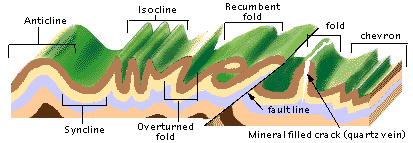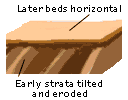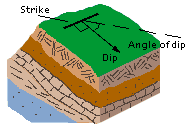Introducing the Geology of Arkansas
LIKE ANY OTHER subject, geology can be made fun or boring, depending on how it is presented. Several junior high students have told us so! This chapter is designed to tell the stories of the rocks, in a not-so-technical way, and if you learn some basic principles of geology too, so much the better.
"Geo" means the earth, and "logy" is the science of. Thus geology is the science of the earth, and the geologist is the scientist. Geology is different than rockhounding, because it involves research and understanding, much more than the finding and collecting we enjoy when rockhounding. But the two are related, and the more you know about one, the better your understanding of both. Arkansas is a great place to be either a geologist or a rockhound (or both) because the interesting rock formations of our place gave rise to the minerals here!
A Few Geology Illustrations
THE CRUST OF the earth is in slow motion action, constantly being stretched or squeezed. The pressure on the rocks can deform or break them, causing folds or faults. Folds mainly go up and down. The ones that go up are called anticlines, the ones that go down are called synclines. These features can be large enough to be hills and valleys in a mountain range, or can be squiggles seen in a hand-sized rock.

In the Ouachita Mountains of Arkansas, the layers, or strata, of the rocks have been so corrugated and convoluted, that interpretation of events causing these deformations cause considerable debate among geologists.
In other parts of the state, like north Arkansas, nice nearly horizontal layers of rocks can be seen to extend miles across counties. It shows that different forces work in different places.
 The layers of these sedimentary rocks leave a record of events of deposition, with each new layer laid down horizontally over older ones. In some time periods no new sediments were added, or changes in the land caused earlier layers to erode away. These events leave gaps in the sequence of the strata called unconformities. An unconformity represents a contact where beds of rock of different ages meet, instead of a continuous history.
The layers of these sedimentary rocks leave a record of events of deposition, with each new layer laid down horizontally over older ones. In some time periods no new sediments were added, or changes in the land caused earlier layers to erode away. These events leave gaps in the sequence of the strata called unconformities. An unconformity represents a contact where beds of rock of different ages meet, instead of a continuous history.
 The structure of a slope is called its strike and dip. Geologists draw these symbols on maps to define the way beds of rock are at angles, or the way they are dipping. Strike and dip are at right angles to each other. The arrow points in the direction of dip.
The structure of a slope is called its strike and dip. Geologists draw these symbols on maps to define the way beds of rock are at angles, or the way they are dipping. Strike and dip are at right angles to each other. The arrow points in the direction of dip.
The angle of dip is the angle (in degrees) off of horizontal that the bed is dipping. It is usually measured with a Brunton compass and is given by a number like 28 degrees or 45 degrees.
In the links along the side you will find
Our Changing Earth - Plate Tectonics: a continental dance and how scientists figured out that yes, that hump on South America did fit into the hole in the side of Africa
The Geologic Time Scale and a Summary of geologic history in Arkansas, telling what has been going on for all these millions of years
How the Ouachita Mountains formed - the Big Bang from an approaching continent's point of view. The Ouachita Mountains are very old and complex, and geologists puzzle over them.
Your Fault, My Fault, and the New Madrid Fault- Earthquakes, and the story of New Madrid, where the largest earthquake in recorded history happened. It was so big the Mississippi River ran backwards!
The Stories Fossils Tell Fossils tell the story of the earth.
Geology and sources of energy - Coal, oil, gas, uranium: if you can't grow it, you have to mine it